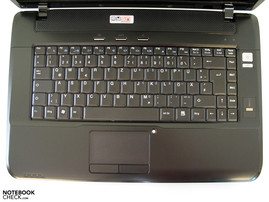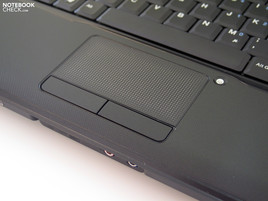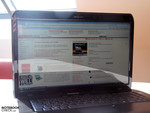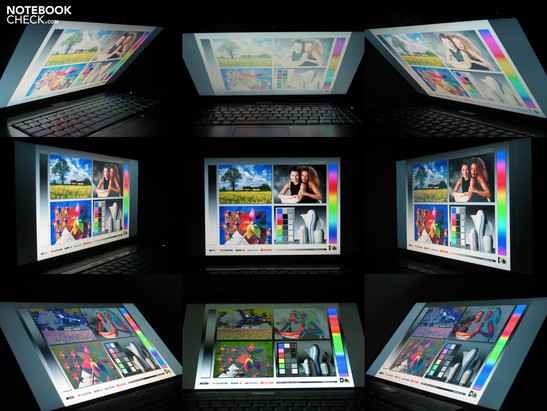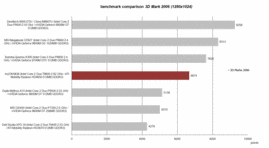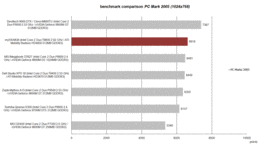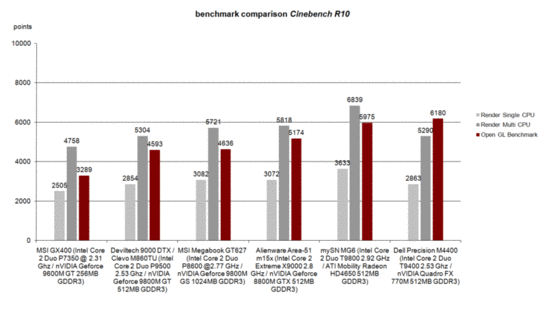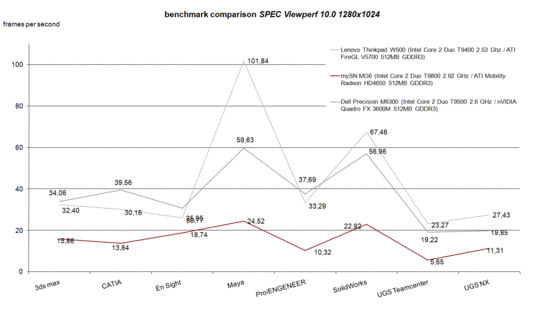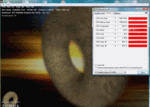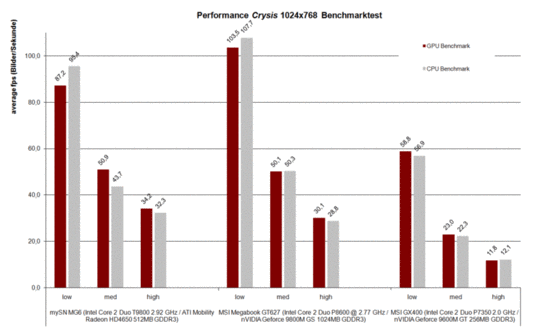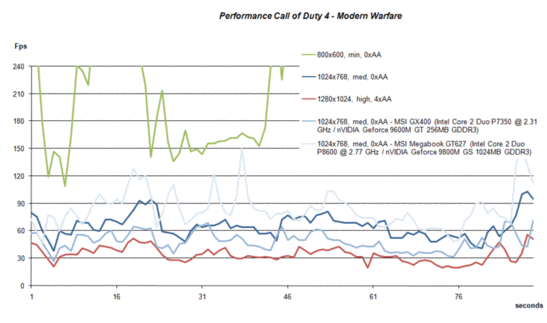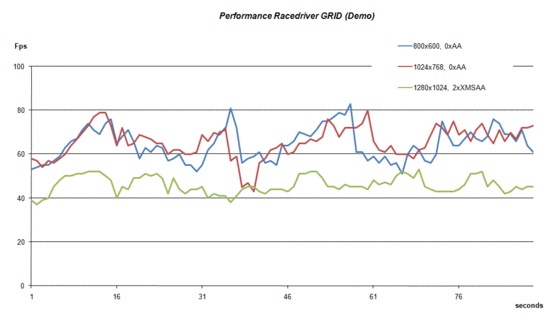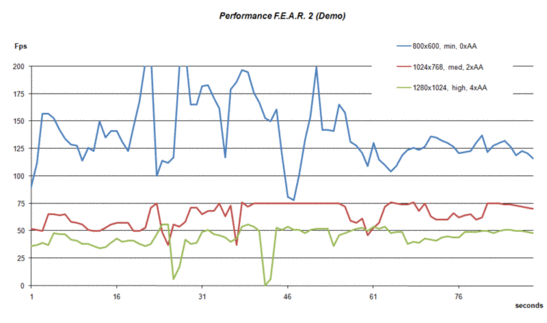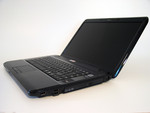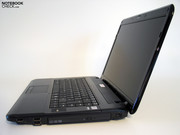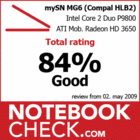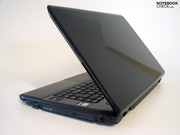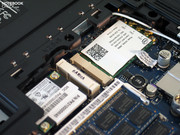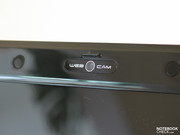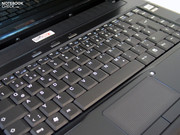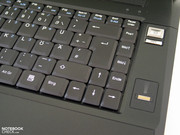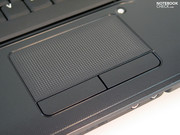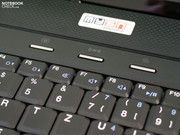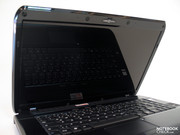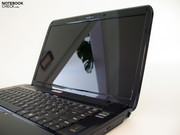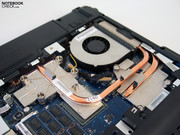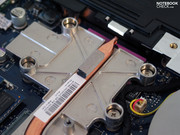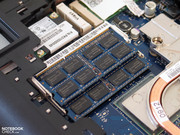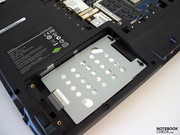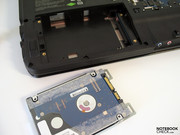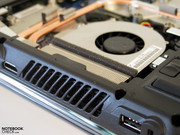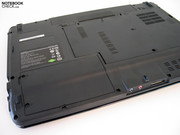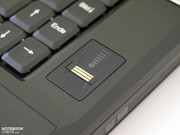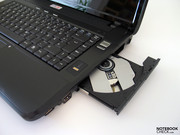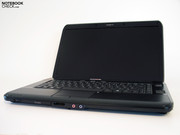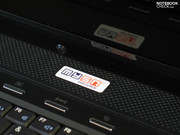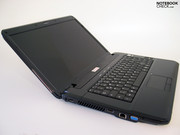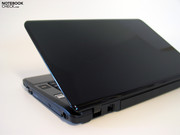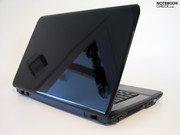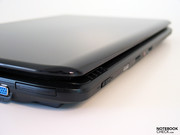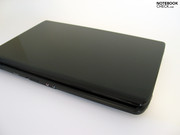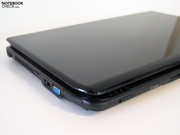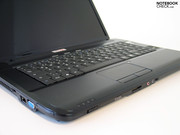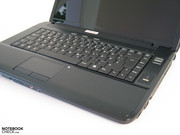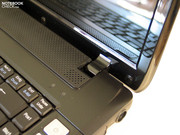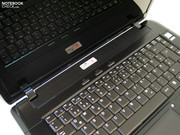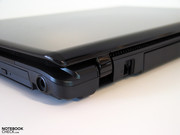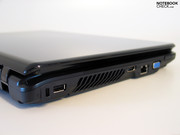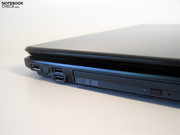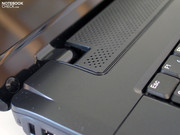Review mySN MG6 Notebook (Compal HLB2)
Bargain for Gamers.
ATI has obviously hit a captivating homerun with the 4600 series. Good performance data and a sizeable price advantage compared to Nvidia's competition make the hardware especially interesting for gaming starters. The German reseller Schenker Notebooks is, for instance, at the very front, bringing out a compact 15.6 inch notebook based on the Compal HLB Barebone with their MG6. We have taken a closer look at the device with an ATI Mobility Radeon HD4650 and Intel Core 2 Duo T9800 with 2.9 GHz.
As it is common in barebones, these can be usually offered in a wide range of different configurations. Aside from numerous CPUs, there are even often various graphic solutions available. However, Schenker Notebooks limit themselves to ATI's Radeon HD4650 in their MG6, so that the gaming notebook remains, above all, in an interesting price range.
We have to admit that the CPU we chose doesn't necessarily meet this ideology. But the tested configuration should support the efficiency of the built in graphic hardware, in order to especially define the performance spectrum of the exciting ATI hardware towards the top.
In contrast to the smallest available CPU (T4200 with 2.0 GHz, 1 MB L2 cache, 800 MHz FSB) the T9800 Intel CPU, currently the most efficient "non-extreme" Dual Core CPU, mounts up to a surcharge of a proud 455.00 Euros. However, if you consider this in the total price of 1440.00 Euros in our high-quality configuration (320 GB, 7200 HDD, 4 GB DDR3 RAM, Win Vista H. Prem. 64) you will rapidly find yourself in the especially fascinating range of under 1000.00 Euros again.
Case
As our colleagues at Notebookcheck.pl have already noted on the Compal HLB2 barebone tested by them, the case isn't exactly the highest quality chassis which Compal has delivered up till now. The applied plastic doesn't look very qualitative and can't really convince, especially in its haptic. The roughened surfaces in the area of the wrist rests and the high gloss finish of the display lid can't change that, either.
Fortunately, the mySN MG6 conducts itself optically rather modestly and presents full black surfaces with very well-designed contours. Due to the rounded edges the case makes a very compact impression, whereas the 16:9 format also contributes to this.
We couldn't observe any irregularities in the gaps of our test sample, but we have to confirm the already criticized wobbly battery.
The stability of the case in the base unit's upper side area turns out as satisfactory. On the bottom side of the case tray it can come to deformations at point pressure, though. The same applies to the display lid, which especially yields in the central area. The noticeable distortions on the presented image luckily stay within a limit, though.
Also worth mentioning is that the display's opening angle is restricted to approx. 140°, which shouldn't lead to any limitation of the notebook's practical use. The hinges hold the display sufficiently tight in place and also prevent a too easy opening from a closed state, as well. This is important as the notebook hasn't any locking catch which secures the display in a closed condition.
Connectivity
The mySN MG6 maybe doesn't have an extraordinarily generous interface configuration, which wasn't to be awaited in view of the price, but you do find everything you need for an undemanding office and gaming use on the notebook, anyway.
A total of four USB 2.0 ports, a LAN, a VGA and an HDMI port can be counted to this. On top of that Compal gave the barebone a 34 mm Expresscard slot, too.
The distribution quality of the ports is, once again, dependant on the intended mission of the device. Righties have a clear advantage through the positioning of the optical drive on the right side edge. But in case of requirement of more than just one USB socket, the triple-grouped USB ports on the right side edge in the front area could turn out to be a bit inconvenient.
The left side edge accommodates the vent, and the remaining interfaces, unfortunately, are all quite in the front area. Lefties will therefore only just have a hard time at an extensive port occupation.
The MG6 is also optionally available with a Blu-Ray drive, which surprisingly affects the total price comparatively little, with a surcharge of 145.00 Euros.
The available Intel Turbo Memory Module, with a capacity of 1, 2 or 4 GB, neither has a significant effect on the price, nor probably on the gaming performance of the device.
Aside from the integrated Realtek Gigabit Ethernet Adapter (RTL8168C(P)/8111C(P)) ex-factory, Schenker has a correlating WLAN module available at a surcharge-item. The two up-to-date Intel modules, WiFi 5100 AGN and WiFi 5300 are offered for 25.00 Euros or rather 40.00 Euros. Bluetooth V2.0 has to be also chosen separately as an additional option and costs an additional 30.00 Euros.
You almost have the whole range of operating systems to choose from, but only for Vista. XP isn't offered. Moreover, at a configuration greater than 3GB you should consider the option of a 64 bit capable operating system so that the total memory can be used under Windows.
Schenker gives a 24 month pickup & return service ex-factory on the MG6, but only in Germany. Contemporaries from Austria, Switzerland and the rest of the new and old Europe still have to shell out the postage themselves in case of a repair. The available warranty extension of up to 36 months, which is obtainable for a rather inexpensive additional charge of 85.00 Euros, can be seen positive.
Input Devices
The built in keyboard doesn't show any irregularities in regards to the given figure keys' size. However, the positioning of the Fn-key on the outer left does seem a bit unusual for a gaming notebook, where the CRTL-key is usually found, which calls up the console of many games in combination with the ^-key. The somewhat thinner cursor keys aren't very helpful in various games, either.
The built in keyboard unit proved to be very pleasant at text-typing. Every key was hit at once and the typing feel was alright, too. This can be described as having a rather soft stroke and a slightly rebounding stop. The discreet clicking noise of the keys was also able to please in the test.
The touchpad turned out relatively large. The gliding-traits of the pad are also okay and make navigating with the pad easily practicable. Not quite as convincing were the touchpad keys which sit fairly deep in the case and can therefore often only be stroked with difficulty by the thumb. The typing feel of the keys also turn out to be a bit awkward, letting themselves only be pressed on the outer side with high pressure, whilst in the central area these respond very easily. The springing noise, which the keys emit isn't very elegant, either.
Due to an own, but somewhat difficult to use button, the touchpad can be deactivated quickly.
Display
The mySN MG6 follows a new trend in regards to the applied display format. In the opinion of media enterprises, the aspect ratio of 16:9 should also converge with notebooks, in order to render contemporary movies as bar-free as possible and to use the display to its maximum. At this point you shouldn't forget that we are still dealing with a mobile PC, for which only a small part of its application field is taken up from playing movies. For many daily tasks, a correlating image height is very much of advantage.
Then we are at the given notebook resolution of 1366x768 pixels. As a result, somewhat of height has been saved and invested into the image width, in assessment to the common 1280x800 format.
The screen (CMO 1571) built into our test device presented a good maximum brightness of 248 cd/m2 in the brightness test. But a massive brightness decrease towards the lower display edge could be observed, where the maximum brightness was merely 181.1 cd/m2. Hence, the mySN MG6 only reaches 75.5% in regards to illumination.
| |||||||||||||||||||||||||
Brightness Distribution: 73 %
Contrast: 188:1 (Black: 1.26 cd/m²)
The maximum given contrast of the built in screen reaches a ratio of 188:1, which is still rather acceptable. Subjectively, the color representation didn't show any irregularities, but there is a brightness decrease downwards on a white background which can even be seen with the naked eye.
The viewing angle stability in the vertical viewing field is, as for many notebook displays common, rather restricted. Already slight deviations from the ideal perpendicular viewing angle have an obvious image distortion as a consequence. The display shows itself as much more tolerable in the horizontal area and allows also inclined viewing angles. But unwanted reflections increase, as well.
Performance
Based on Intel's PM45 chip set, a whole range of processors can be employed in the Compal HLB2 barebone. This applies to older CPUs of the Merom generation from Intel, which is offered as the T4200 CPU with 2.0 GHz as a starter option in the mySN MG6. This is followed from a whole row of state-of-the-art Intel Penryn chips up to the T9800 CPU with 2.92 GHz, 6MB L2 cache and 1066MHz Frontsidebus (FSB). You can discover how the single processors differ in their efficiency either in our Benchmark List of Mobile Processors or in this special editorial about Intel's current Penryn CPU generation.
The T9800 CPU belongs to the currently most efficient dual core processors, but is also an especially expensive solution with a price of 530.00 dollars (Intel's retail price at a purchase of 1000 pieces). Significantly more exciting, in regards to money for value, would be the P8400 and P8600 chips, which are available at a considerably lower price and bid good performance, as well. They also make a small contribution to the heating up of the device and to power consumption in battery mode with a TDP of 25W.
The built in graphic card, a Mobility Radeon HD 4650 von ATI, scored unsurprisingly well. Equipped with a 512 MB fast GDR3 storage module, ATI's new middle class graphic provides for first class benchmark results and admonishes the previous precursor of this league, the GeForce 9600M GT, back to the lower ranks. In the executed 3D Mark 2006, for instance, the HD 4650 establishes itself in about half way between 9600M GT and 9700M GTS.
The good result in the PCMark 2005 shows that the total system in combination with the efficient T9800 CPU, a total of 4GB DDR3 RAM and a fast 320GB hard disk with 7200 rpm isn't necessarily "half bad". The test system shoves itself in front of similar or even better equipped devices with a reached 6618 points.
You can usually observe the ATI graphic to also scores well in the Cinebench R10 Benchmark Test. Hence, we naturally took a closer look at the MG6 with the ATI HD 4650 graphic in this exercise – and justifiably so as the good result shows.
With its achieved 5975 points in the OpenGL Rendering Test, the mySN MG6 scratches at the score of the CAD Pro Dell Precision M4400 with Nvidia Quadro FX 770M graphic. The T9800 CPU's result in the rendering test naturally turned out impressive, too. The chip can only be closed in by quad-core processors with 6839 points in the Multi-CPU test.
The MG6 might also be possibly interesting for CAD users, seeing the excellent result in the Cinebench R10 Shading Test. We have to muffle our expectations in this exercise, though.
The MG6 from Schenker only reached average results in the SPEC Viewperf benchmark test, which doesn't make a use of the notebook in the CAD field very advisable.
Furmark
There are always again reports to be heard wherein is stated that especially ATI graphic cards have problems with the benchmark and stress test Furmark, which would render a hairy donut under the light of OpenGL and so make the graphic card's shader units get into a real sweat.
The executed stability test let the GPU's temperature (singled out with the tool GPU-Z) rise up to a maximum of 100°C. The heating then remained stable in this area, and settled at a chip temperature of approx. 98°C after about 1-2 hours of load.
The graphic card's clock rate also remained stable at maximum with a core clock of 600 MHz and a memory clock of 796.5 MHz. In comparison to the MSI GX625 with an ATI HD 4670 tested by our Polish colleagues, the observed temperatures are relatively high. Hence, the cooling system in the MG6 most probably operates rather at its limit.
The tests were executed at a surrounding temperature of 22°C. At higher surrounding temperatures, of course, an even stronger heating of the chip can't be expelled. In comparison to the competition from Nvidia, the heating turns out very high, anyway. The GeForce 9600M GT in the HP HDX16 reached in the comparison test a maximum temperature of 86°C. The differing cooling mannerisms of both devices should be considered here, though.
Random Access Memory / Hard Disk
As already mentioned in the beginning, our test sample has an apt RAM configuration in form of two 2GB memory bars, type DDR3 PC3-85000F. Therefore the mySN MG6 also reaches the maximum possible memory configuration given by Schenker. So that the whole storage capacity is available under Windows, the test system has been appropriately fitted with a 64 Bit operating system.
Schenker also offers a whole range of options in regards to mass storage. Either there is the common hard disk from Seagate, with a velocity of 5400 rpm or even 7200 rpm and a capacity of up to 500 gigabytes, or there is also the high-quality Solid State Drives (SSD) from OCZ to be built in. A 60 GB memory for an additional 115.00 Euros defines the SSD starter variant. Theoretically, there is also even one of the top models available from OCZ, a 250GB SSD out of the Vertex series, which would, with a proud 820.00 Euros, cost even more than the whole notebook in its basic configuration…
You are also completely well-provided for with a 320GB disk and a velocity of 7200 rpm, which probably has the best money for value ratio at a surcharge of 40.00 Euros. This storage was also built in to our test device. The hard disk reached an attractive average transfer rate of 68.8 MB/sec as well as a very short access rate of merely 15.8 milliseconds in the HDTune benchmark test.
| 3DMark 2001SE Standard | 32698 points | |
| 3DMark 03 Standard | 21712 points | |
| 3DMark 05 Standard | 14191 points | |
| 3DMark 06 Standard Score | 6674 points | |
| 3DMark Vantage P Result | 2727 points | |
Help | ||
| PCMark 05 Standard | 6618 points | |
| PCMark Vantage Result | 4515 points | |
Help | ||
Gaming Performance
The first results of the executed benchmarks give hope for a very positive gaming performance. As usual, we therefore put a whole row of game to a practical test in order to make more precise statements.
Crysis
The ATI Mobility Radeon HD 4650 has to take the challenge of this demanding first-person shooter from EA Games in the frame of our test of the mySN MG6 - very successful as the following results show.
For instance, the achieved values of the GeForce 9600M GT in the MSI GX400 could be easily topped, yes, even almost doubled. The comparison to the principally as more efficient classified Geforce 9800M GS from Nvidia turned out to be not less impressive. The results of the 9800 could be reached at middle details and at high details the HD 4650 was even slightly over that of the GeForce 9800M GS in the MSI GT627.
GTA IV - Grand Theft Auto
The latest edition of the Grand Theft Auto series, GTA IV, probably counts to one of the most hardware-exhaustive games at the moment. The mySN MG6 reaches an average of 46.49 fps in the game-integrated benchmark test in the lowest settings (all min, out 800x600). The bargain gamer scores, here as well, slightly better than the MSI GT627 with the GeForce 9800M GS, which reaches 41.36 fps in comparison.
A graphic detail increase to medium (all medium; view 21, detail 10, vehicles 50, shadow 8; 1024x768) depresses the average frame rate to 36.8 fps in the test. The GT 627 merely reaches 19.44 fps with a regular clocked P8600 CPU. In Turbo Mode (2.77 GHz) the value improved itself to 31.56 fps. This, however, shows the massive influence of the CPU in GTA IV, where the tested MG6 with its efficient T9800 CPU certainly has a clear advantage.
Call of Duty 4 – Modern Warfare
A must for a gaming device is of course also the as before favored shooter Call of Duty 4. The ATI HD 4650 delivered a good performance here, as well. The notebook made an average of about 66.5 fps at a resolution of 1034x768 and medium details and deactivated anti-aliasing and can leave the, for instance, MSI GX400 with the GeForce 9600 behind. The MSI GT627 with the 9800M GS graphic doesn't let itself be beaten so quickly in this exercise, though. It still lies ahead of the MG6 with an average of approx. 84 fps.
It gets tight for the mySN MG6 at a further resolution increase to 1280x1024 pixels, high detail settings and quadrupled anti-aliasing. The performance moves around 30 fps, whereas an occasional crash, that is to say studdering, has to be counted with. The GT627 with a Nvidia 9800 GS graphic remains significantly more stable and within a playable range with an average of 47.7 fps.
Race Driver GRID
The current racing game Racedriver GRID is even playable with attractive graphics. No matter if at minimum settings, hence a resolution of merely 800x600 pixels and deactivated anti-aliasing, or an even more worth seeing 1024x768 pixels – the performance always stays at an absolutely smooth playable range with about 60 fps.
A resolution increase to 1280x1024 pixels and 2xXMSAA is also tucked away without noticeable problems. The observed frame rates were practically stable at over 40 fps and therefore also in the smooth area.
F.E.A.R. 2
Among others, the sequel of the horror shooter FEAR belongs to the currently available gaming titles. There is also nothing to criticize on the mySN MG6's performance up to a resolution of 1024x768 pixels, medium details and double anti-aliasing. The device first gives in at 1280x1024 pixels, high graphic settings and activated quadrupled anti-aliasing.
The notebook may deliver a mostly still playable frame rate at about 30 fps, but short crashes flaw the gaming enjoyment.
Emissions
System Noise
A constant running fan could be observed even at use of the mySN MG6 without, or rather with a low load, so in office mode while surfing in the internet or even in idle mode. This can be described as very audible, but due to its pitch still very tolerable, with a volume of 34.9 dB(A) on our indicator scale. Depending on its performance requirement it could happen that the fan increases its velocity for a short period in office mode and therefore attracts attention.
The mySN MG6 reaches its maximum volume of 44.2 dB(A) under load. Occasionally to be called loud, the soundscape can still be coped with at gaming.
Noise level
| Idle |
| 34.2 / 34.2 / 36.5 dB(A) |
| HDD |
| 34.5 dB(A) |
| DVD |
| 42.1 / dB(A) |
| Load |
| 44.2 / 44.2 dB(A) |
 | ||
30 dB silent 40 dB(A) audible 50 dB(A) loud |
||
min: | ||
Temperature
The maximum values under load were noticeably high, even on the upper side of the base unit. The case reached peak values of up to 45.8°C. This will also be perceived at gaming, because you usually have a hand positioned in the area of the A-W-S-D keys.
The established values on the case's bottom side turn out less disturbing and slightly lower. Maximum values of up to 44.6°C were noted here.
(-) The maximum temperature on the upper side is 45.8 °C / 114 F, compared to the average of 36.9 °C / 98 F, ranging from 21.1 to 71 °C for the class Multimedia.
(±) The bottom heats up to a maximum of 44.6 °C / 112 F, compared to the average of 39.2 °C / 103 F
(±) The palmrests and touchpad can get very hot to the touch with a maximum of 37.6 °C / 99.7 F.
(-) The average temperature of the palmrest area of similar devices was 28.7 °C / 83.7 F (-8.9 °C / -16 F).
Loudspeakers
Both loudspeakers built in above the left and right keyboard side have a very predominant place, but their tone sounds surprisingly modest. This is still more acceptable at sound rendering during gaming than at playing music. We would recommend the use of headphones or even external loudspeakers here.
Battery Life
As Schenker rightly notes in their online-configurator, the battery life is strongly dependant on the individual configuration. Because the arrangement of our test sample is more orientated on the MG6's maximum performance, the following assessments are to be seen as an informative basis for the "worst case" scene for the MG6. Less efficient CPUs should therefore have a positive effect on the possible battery runtime.
In the BatteryEater Reader's test, representative for the maximum battery runtime to be awaited at minimum display brightness, deactivated WLAN in the Window's energy savings profile, the mySN MG6 reached 292 minutes, so short of 6 hours.
A dramatic decrease of the runtime is observed under load. The runtime drops to merely 51 minutes in the BatteryEater Classic Test (load, max. display brightness, WLAN on, high performance profile) and is therefore no longer relevant for practical use.
A runtime of approx. 260 minutes can be counted with during the practical surfing mode at maximum display brightness and activated energy savings profile. This suffices for an extensive wireless notebook use.
| Off / Standby | |
| Idle | |
| Load |
|
Key:
min: | |
Verdict
The expectations of the Compal barebone were rather low in view of the mySN MG6's acquisition price of just about 649.00 Euros, but without an operating system and a generally very scanty configuration. Even the conservative plastic case with the impression of moderate quality wasn't much of a surprise. The positioning of the ports is also a justified critique point on the HLB2.
However, the notebook's efficiency exceeded our expectations, especially the Mobility Radeon HD 4650 from ATI. The chip presented a first class 3D performance and even caught up to the performance of a GeForce 9800M GS from its competitor Nvidia in the single gaming tests. Equipped with the most state-of-the-art drivers from Nvidia, the GeForce 9800M GS, should however remain clearly in the front and have the whip hand at higher resolutions and detail levels in regards to performance.
As it is, the ATI 4650 places itself rather in the middle class field, anyway and can clearly detach the here mostly represented GeForce 9600M GT chip. According to first rumors on the portal VR-Zone, Nvidia will probably first be able to counter with the 40nm technology in the upcoming graphic card generation, which is anticipated to come on the market in the second half of 2009.
That the graphic chip reached a constant temperature of approx. 98°C under load (Furmark) was conspicuous, though. Even if there weren't any problems established in the test, you might just want to take the 3 year warranty upgrade, which is relatively inexpensive to avail at a surcharge of already 85.00 Euros, in order to keep a peace of mind.
The MG6 could very well be mentioned as a tip for thrifty, occasional gamers, even if it has a whole row of smaller flaws. Up till now, it is difficult to find such a load of performance at this price.









